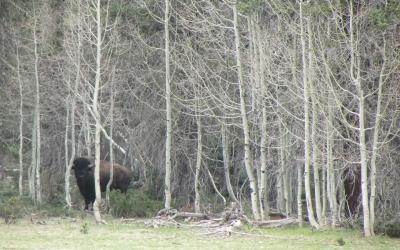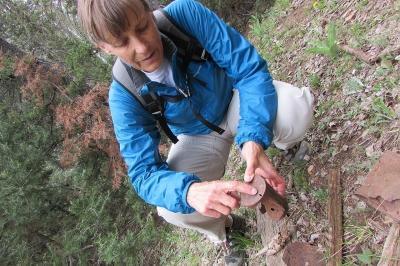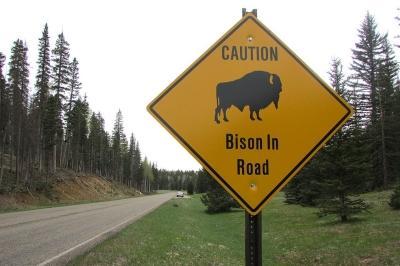by Carrie Jung / Al Jazeera

An adolescent bull in the woods at the north rim of the Grand Canyon keeps an eye on Martha Hahn, the science director of Grand Canyon National Park, as she hikes through. Photo: Carrie Jung
GRAND CANYON, Ariz. — Martha Hahn had been hiking for only about 15 minutes when she spotted him.
“Wait, I think I see one,” she whispered enthusiastically.
Hahn slowed to a halt and leaned in for a closer look. Further inspection through a zoomed camera lens revealed that the dark figure at the meadow’s edge was a bison.
“He’s keeping an eye on us,” she said as she watched the adolescent bull retreat into the woods.
As Grand Canyon National Park’s science director, Hahn knows a lot about the habits of bison. However, this knowledge base is not something she’s particularly happy to be using here.
“Bison are important in the overall context of our culture,” she explained. “But at the same time, in their place.”
“Place” being the key word here. Grand Canyon National Park is not traditional habitat to resident bison; however, today it’s home to more than 300, and their numbers are growing exponentially. Because the animals did not evolve with the park’s environment, their presence is beginning to take a toll on the area’s native species.
Sensitive habitats and archaeological sites are at stake, and wildlife managers are now trying to figure out how to reduce the population to a manageable size.

Martha Hahn, director of science at Grand Canyon National Park, says that heavy grazing by the bison has led to soil erosion and invasive plant species. Photo: Carrie Jung
The National Park Service, the U.S. Forest Service, the Arizona Game and Fish Department and the Bureau of Land Management are working together on this issue and have come up with several options to more effectively manage the bison population. Some of the tactics being considered include tools that would influence their migration, like hazing, baiting and the manipulation of water sources. Lethal removal is also an option on the table.
Because the bison are residing on federal land, officials must subject their potential plans to public comment. The general public has until midnight Friday to submit comments.
The problem of poop
A series of public meetings and webinars has already been held. About 30 people made it to the last public meeting in Phoenix on April 30, and they all had strong opinions about how the situation should be handled.
Sandy Bahr, executive director of the Sierra Club of Arizona, maintained that because bison did not historically inhabit the Grand Canyon, they all need to go.
“The park service has a responsibility to protect those resources and protect the native wildlife and the native plant species,” she said. Bahr added that she hoped the Park Service would consider nonlethal methods of removal.
Arizona resident Jim Ingram held strong in his belief that the bison are an important part of our culture, and at least a few of them needed to remain in the park.
“I hope to see future generations in this country have more buffalo present in more places,” said Ingram. He was also very upset to hear the park was considering lethal tactics. “And that’s not going to fly,” he added.

It’s rare, but occasionally vehicle collisions with bison do happen. Photo: Carrie Jung
According to Hahn, a reduction in numbers is necessary, as the impact of the bison herd is becoming hard to manage at Grand Canyon. One of the most noticeable problems to visitors is the ubiquitous presence of their poop.
As Hahn continued her hike, she looked down as she walked to avoid stepping in a cow pie. In open areas of the park, piles of bison feces lie just feet from each other, and the smell of manure permeates the air.
To produce that manure, these bovines must also consume a large amount of grass, which is causing other problems. Their hefty appetites have left much the area’s grassland dotted with bare spots.
“If you look, this meadow looks like a well-manicured lawn,” said Hahn as she gazed across the landscape. She explained that the grass here should naturally be at least a foot tall. Instead, much of it barely reaches an inch in height.
Hahn added that such heavy grazing and soil erosion have left the area vulnerable to an infestation of invasive plant species. She said that while the native plants have so far managed to keep a stronghold in the park, “we are seeing more and more invasives, especially where the bison are.”
History of a herd
Grand Canyon National Park does fall within the southern edge of the bison’s natural range; however, according to Carl Lutch, the wildlife program manager at the Arizona Game and Fish Department,“they’re a little further from home than they should be.” And that’s part of the problem.
State wildlife managers used to rely on hunters to control the population, but since the herd migrated to the national park, that was no longer an effective option, as hunting there is prohibited.
He explained that this family of bison has been in northern Arizona only for about 100 years. A man named Charles “Buffalo” Jones introduced them to breed with cattle in 1906. Jones’ crossbreeding efforts ultimately failed, though, and 20 years later about 98 of their descendants were sold to the state.
Since the 1950s, the Arizona Game and Fish Department has been managing the herd in the House Rock Wildlife Area, rangeland that lies a few miles northeast of Grand Canyon National Park.
However, that has changed in the past 15 years. Lutch explained that state hunting practices were partly to blame for the migration to the park. Once the bison were allowed to freely roam in the House Rock Wildlife Area, they became wise to the fact that they were being pursued, “so they started seeking areas away from the hunting pressure and away from people,” added Lutch.
Having so many of these animals in the park is a lose-lose situation for most of the area’s land managers. The Game and Fish Department doesn’t want them there because it reduces the success of state-sanctioned bison hunts. And National Park officials want them out because they say the herd is trampling on archaeological sites and straining the area’s natural resources.
Back at Grand Canyon National Park, Hahn has knelt to inspect a hand-size hoof print near a small lake. Heavy bison traffic has turned its banks into a muddy mess.
“We need to respond to the fact that we have an issue,” she said. Hahn added that she’s happy to know the planning process has started, because if action isn’t taken soon a herd this size could significantly damage the park’s delicate environment.

